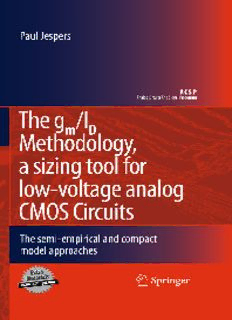Table Of ContentThe g /I Methodology,
m D
A Sizing Tool for Low-voltage
Analog CMOS Circuits
ANALOGCIRCUITSANDSIGNALPROCESSINGSERIES
ConsultingEditor:MohammedIsmail.OhioStateUniversity
Forothertitlespublishedinthisseries,goto
www.springer.com/series/7381
The g /I Methodology,
m D
A Sizing Tool for Low-voltage
Analog CMOS Circuits
The Semi-empirical and Compact
Model Approaches
By
PaulG.A.Jespers
UniversitéCatholiquedeLouvain
Louvain-la-Neuve,Belgium
123
Prof.PaulG.A.Jespers
UniversitéCatholiquedeLouvain
Louvain-la-Neuve
Belgium
[email protected]
Additionalmaterialtothisbookcanbedownloadedfromhttp://extra.springer.com.
ISBN978-0-387-47100-6 e-ISBN978-0-387-47101-3
DOI10.1007/978-0-387-47101-3
SpringerDordrechtHeidelbergLondonNewYork
LibraryofCongressControlNumber:2009940107
(cid:2)c SpringerScience+BusinessMedia,LLC2010
Allrightsreserved.Thisworkmaynotbetranslatedorcopiedinwholeorinpartwithoutthewritten
permission of the publisher (Springer Science+Business Media, LLC, 233 Spring Street, New York,
NY10013, USA),except forbrief excerpts inconnection with reviews orscholarly analysis. Usein
connectionwithanyformofinformationstorageandretrieval,electronicadaptation,computersoftware,
orbysimilarordissimilarmethodologynowknownorhereafterdevelopedisforbidden.
Theuseinthispublicationoftradenames,trademarks,servicemarks,andsimilarterms,eveniftheyare
notidentifiedassuch,isnottobetakenasanexpressionofopinionastowhetherornottheyaresubject
toproprietaryrights.
Printedonacid-freepaper
SpringerispartofSpringerScience+BusinessMedia(www.springer.com)
toDenise
and
tomyparents
OscarJespers
andMiaCarpentier
Foreword
IC designers appraise currently transistors sizes while having to fulfill simulta-
neously a large number of objectives like a prescribed gain-bandwidth product,
minimal power consumption, minimal area, low-voltage design, dynamic range,
non-lineardistortion,etc.Makingappropriatedecisionsisnotalwaysobvious.How
tomeetgain-bandwidthspecificationswhileminimizingpowerconsumptionofan
Op.Ampwithoutareapenalty?Shouldmoderateinversionbepreferredtostrongin-
version?Issizinganartoramixtureofdesignexperienceandrepeatedsimulations?
Or is it a constrained multivariate optimization problem? Optimization algorithms
areattractivewithoutdoubtbuttheyrequiretranslatingnotalwayswell-definedcon-
ceptsintomathematicalexpressions.Theinteractionsamidsemiconductorphysics
andsystemsarenotalwayseasytoimplement.
The objective of the book is to devise a methodology enabling to fix currents
andtransistorswidthsofCMOSanalogcircuitssoastomeetspecificationssuchas
gain-bandwidthwhileoptimizingattributeslikelowpowerandsmallarea.Aspecial
attentionisgiventolow-voltagecircuits.Thesizingmethodtakesadvantageofthe
g =I ratioandmakesuseofeither‘semi-empirical’dataorcompactmodels.The
m D
‘semi-empirical’approachutilizeslargelook-uptablesderivedfromphysicalmea-
surements carried out on real transistors or advanced models. The compact model
approach offers the possibility to make use of analytic expressions. Unfortunately
whenitcomestorealtransistors,especiallysub-microndevices,thisisn’ttrueany-
more. Other means are necessary to keep track of high order effects without the
risktoloosetheinherentsimplicityofcompactmodels.Biasdependentinsteadof
constant parameters offer the possibility to extend the validity of a model like the
E.K.V.model.
Inthefirstchapter,theIntrinsicGainStage,issizedmakinguseoftheclassical
strongandweakinversionlargesignalmodelsofMOStransistors.Thisleavesopen
themoderateinversionregion,aregionthatoffersthebestcompromisesgenerally
as far as power consumption and sizes. To be able to size circuits in moderate in-
version,weneedareliablelargesignalMOSmodel.TheChargeSheetModelthat
isconsideredinChapter2isaninvaluabletoolforunderstandingthemechanisms
governing current in MOS transistors, but it is not fitted for real transistors for it
relies on the gradual channel approximation and makes use of mathematical ex-
pressions that are too complicated. The MATLAB tools that are available under
vii
viii Foreword
‘extras.springer.com’ overcome the mathematical aspects and offer the possibility
to perform ‘ideal experiments’. Some of the abstract aspects of the Charge Sheet
ModelmoreoverarebridgedinChapter3bytheintroductionofagraphicalrepre-
sentationofthedraincurrentthatcombinesphysicalaspectsandpracticalcircuits.
The E.K.V. basic model discussed in Chapter 4, offers clearly more flexibility.
ItisanapproximationoftheChargeSheetModelandaforerunnerofwhatisviewed
nowadaysascompactSurfacePotentialModels.Themodelpavesthewaytowards
analytical expressions not only for the drain current but also for the terminal volt-
ages whatsoever the mode of operation of the transistor, whether saturated or not.
Unfortunately,thesimpleE.K.V.modelisagradualchannelmodelliketheCharge
SheetModel,unfitthusforrealtransistors,inparticularshortchanneldevice.
ThefactthatdraincurrentspredictedbytheE.K.V.compactmodellooksosimi-
lartorealdraincurrentsopensthequestionwhetherthemodelcouldnotbeextended
torealdevices.InChapter5,weshowthatcurrentsveryclosetorealdraincurrents
canbepredictedwhentheparametersoftheE.K.V.modelvarywithbias,evenwith
100 nm devices. The explanation may be the quasi-one-dimensional nature of the
channelopposedtothetwo-dimensionalspacechargebelowtheinversionlayer.As
a result, gradual channel conditions prevail in the inversion layer any longer than
inthespacechargewhenthegatelengthisshrinking.Analgorithmisproposedto
acquirethemodelparameters.
TheIntrinsicGainStageisreconsideredinChapter6inthelightofthevariable
parameterscompactmodel.Currentsandtransistorwidthobtainedbymeansofthe
compactmodelreproduceverycloselythevaluesobtainedbymeansofthe‘semi-
empirical’ method. A series of examples considering a low-frequency and a one
GHzgain-bandwidthproductI.G.S.aredescribed.
TheremainingChapters7and8extendthemethodrespectivelytothecommon-
gatestageandtothebasicMillerOp.Amp.Thelatterillustrateshowtomeetboth,
specificationsandattributes.Specificationsconcernthegain-bandwidthproductand
phase margin, attributes low power and area. These determine optimal regions in
the2DsizingspacedefinedbythefirstandsecondstagesoftheMillerOp.Amp.A
MATLABfilecomparesdesignstrategies.
IwanttoexpressmygratitudetoPietWambacqfortheopportunityhegaveme
to check the validity of the variable parameter E.K.V. model on a 90 nm technol-
ogy developed by IMEC. I am also very thankful Prof. Gilbert Declerck, former
PresidentCEOandLudoDeferm,executivevice-presidentofIMEC,whogaveme
permissiontopublishtheresultsandthedatalistedunderthe‘extras.springer.com’.
MysincerethanksgotoProf.FernandoSilveirawhopublishedin1996thefirst
paper illustrating the potential of the g =I methodology. I want to thank him as
m D
wellasProf.A.Vladimirescufortheverydetailedcommentsandsuggestionsthey
made of the first chapters. I also want to associate Prof. D. Flandre to my thanks
owing to our long-term collaboration at the Microelectronics lab of the Universite´
CatholiquedeLouvain.
ThoughthespecificcurrentputtouseinthebookistheonedefinedintheE.K.V.
model,Iowemuchtotworesearchgroups.IamindebtedtoProf.EricVittozforthe
Foreword ix
E.K.V.model,andtoProf.CarlosGalup-MontoroandMarcioC.Schneiderforthe
A.C.M.model.Ithankthesupportersofthetwomodelsformotivatingdiscussions
andinparticulartheopportunityProf.MontoroandSchneidergavemetovisitthem
attheFederalUniversityofSantaCatarina,Brasil.
Tervuren,July2009 P.Jespers
Contents
1 SizingtheIntrinsicGainStage............................................... 1
1.1 TheIntrinsicGainStage................................................ 1
1.2 TheIntrinsicGainStageFrequencyResponse........................ 1
1.3 SizingtheIntrinsicGainStage......................................... 3
1.3.1 SizingtheI.G.S.withtheQuadraticModel................. 4
1.3.2 Sizing the I.G.S. by Means of the Weak
InversionModel.............................................. 4
1.3.3 SizingtheI.G.S.intheModerateInversionRegion........ 5
1.4 Theg =I SizingMethodology...................................... 7
m D
1.5 Conclusions............................................................. 8
2 TheChargeSheetModelRevisited.......................................... 11
2.1 WhytheChargeSheetModel?......................................... 11
2.2 TheGenericDrainCurrentEquation.................................. 11
2.3 TheChargeSheetModelDrainCurrentEquation.................... 13
2.4 CommonSourceCharacteristics....................................... 15
2.4.1 TheI .V /Characteristics ................................. 15
D D
2.4.2 TheI .V /CharacteristicoftheSaturatedTransistor..... 17
D G
2.4.3 DriftandDiffusionContributionstotheDrainCurrent.... 18
2.5 WeakInversionApproximationoftheChargeSheetModel ......... 18
2.6 Theg =I RatiointheCommonSourceConfiguration............. 20
m D
2.7 CommonGateCharacteristicsoftheSaturatedTransistor ........... 23
2.8 AFewConcludingRemarksConcerningtheC.S.M.................. 24
3 GraphicalInterpretationoftheChargeSheetModel ..................... 25
3.1 AGraphicalRepresentationofI ..................................... 25
D
3.2 MoreontheV Curve.................................................. 28
T
3.3 TwoApproximateRepresentationsofV ............................. 29
T
3.3.1 The‘Linear’SurfacePotentialApproximation............. 29
3.3.2 The‘Linear’ThresholdVoltageV Approximation........ 31
T
3.4 AFewExamplesIllustratingtheUseoftheGraphicalConstruction 32
3.4.1 TheMOSDiode.............................................. 32
xi
Description:How to determine transistor sizes and currents when the supply voltages of analog CMOS circuits do not exceed 1.2V and transistors operate in weak, moderate or strong inversion? The gm/ID methodology offers a solution provided a reference transconductance over drain current ratio is available. The r

